Blocken
 |
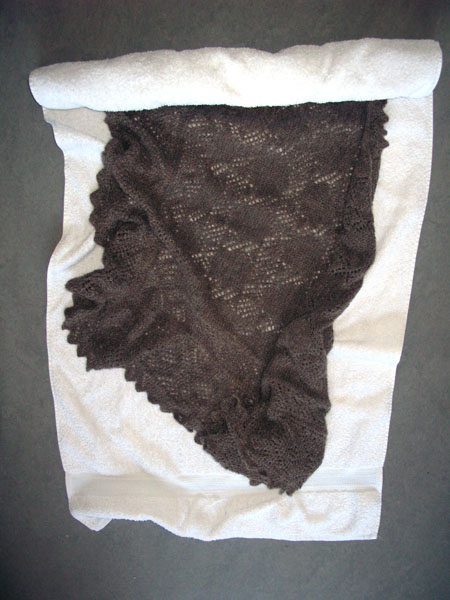 |
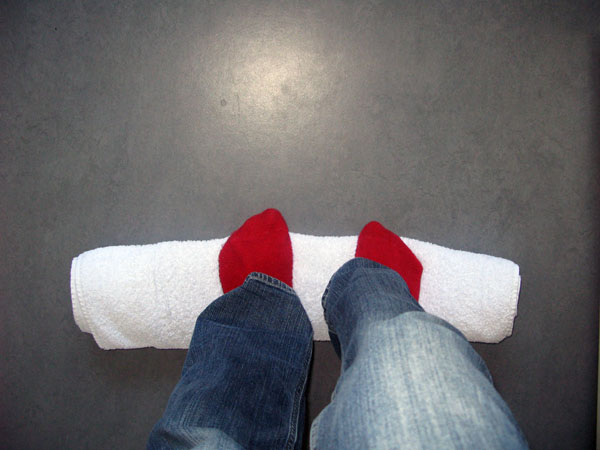 |
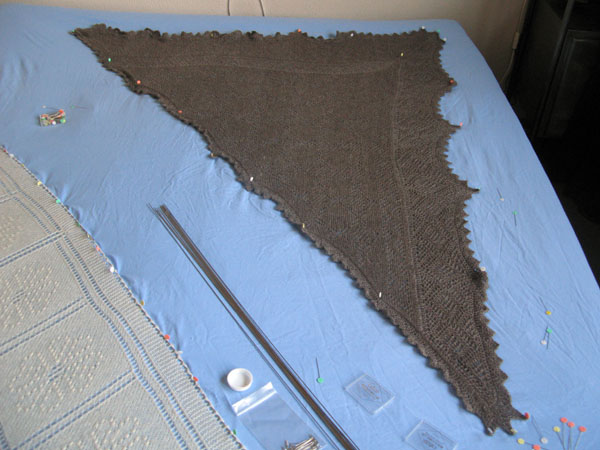 |
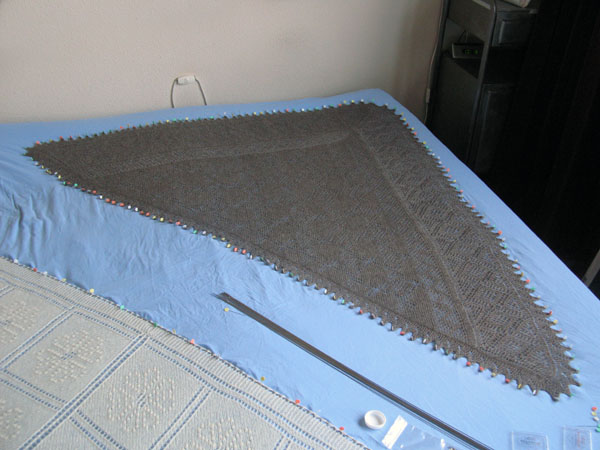 |
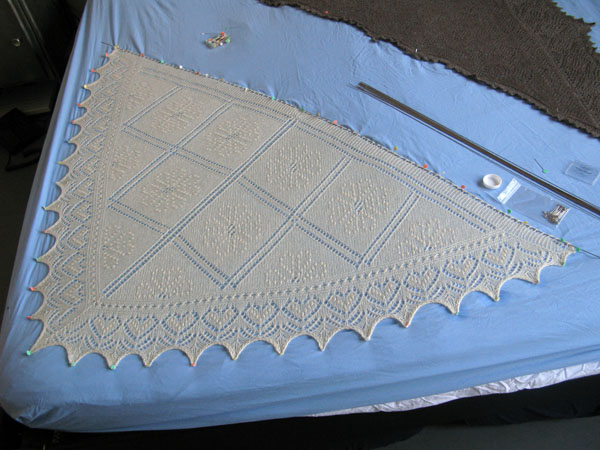 |
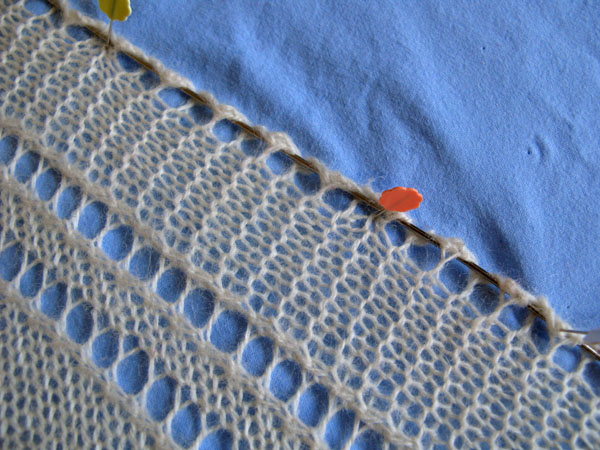 |
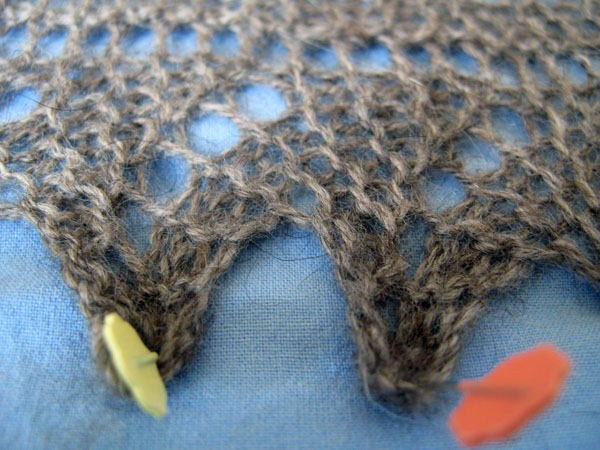 |
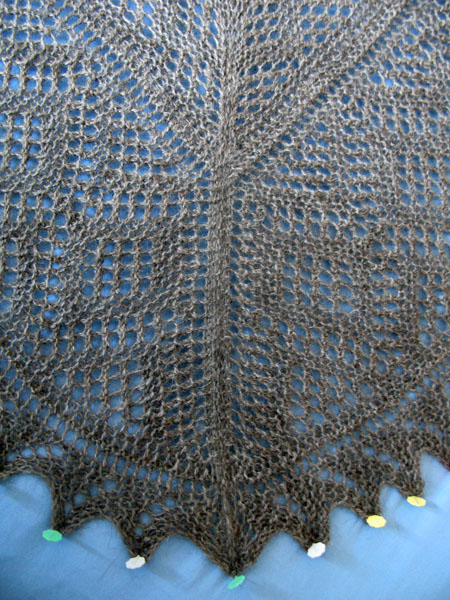 |
| Klik op afbeelding voor vergroting – Click to enlarge images | ||
Er gaat haast geen workshop voorbij of een cursist vraagt het….. ‘Wat is blocken eigenlijk?’.
In de jaren tachtig breide ik me ook al een slag in de rondte, maar van blocken (opspannen) had ik nog nooit gehoord. Ik stoomde hooguit de panden van een trui of vest een beetje in model, maar dat was alles. Nu block ik vrijwel alles wat ik brei. Kledingstukken block ik zacht, zodat het werkstuk amper groeit. Kantwerk, zoals kanten shawls block ik lekker stevig zodat de kantpatronen zich openen en het weefsel mooi kantachtig wordt.
There isn’t a workshop without a student asking….. ‘What is blocking?’
In the eigthies I also knitted a lot, but I had never heard about blocking. I sometimes steamed the parts of a garments before sewing them together, but I never blocked anything. Nowadays I block everything I knit. Garments I block softly, so the project hardly grows larger. Lace, like shawls, I block to the max so the patterns open up and the fabric is lacy and crisp.
Uitleg blocken
– Werk de losse draadeinden nog niet af.
– Leg een wollen werkstuk minimaal 15 minuten in een lauw-koud badje met wat Eucalan. Zijde zo kort mogelijk weken. Af en toe knijpen en husselen, maar vooral niet wringen.
– Haal het werkstuk uit het badje en knijp het water eruit.
– Rol het werkstuk in een droge schone katoenen handdoek, leg het rolletje op de grond en doe er een dansje op. Herhaal eventueel met nog een droge handdoek. Is het erg nat, trek je sokken uit! 😉
Blocken met spelden
– Zet de hoekpunten en een paar punten daartussen vast op de ondergrond met spelden.
– Voeg spelden toe en probeer zonodig ondertussen of je geheel nog wat extra kan spannen.
– Zet ieder puntje vast met een speld. Let op dat de spelden meer dan één lusje zitten, ander krijg je lelijke puntjes en de draad kan dan breken.
Blocken met staafjes (wires – blocking set)
– Rijg de staafjes door de gaatjes in de zijkanten van het werkstuk. Bij rechte zijkanten rijg je de staafjes door zoveel mogelijk gaatjes, bij geschulpte zijkanten alleen door de uiterste puntjes van de schulpjes.
– Leg het werkstuk met de staafjes erin op de ondergrond en span door de staafjes uit elkaar te trekken en te fixeren met spelden.
– Laat het werkstuk minimaal acht uur drogen.
– Haal het werkstuk van de ondergrond en werk de draadeinden af.
How to block
– Don’t weave in loose ends.
– Put a woollen project in a luke warm (almost cold) bath with Eucalan for at least 15 minutes. Silk should not be soaked too long. Move the knitted fabric a bit around now and then, squeeze it, but never wring it.
– Get the fabric out of the bath and squeeze out most of the water.
– Roll it in a clean, dry, cotton towel. Lay the roll on the grond and dance on it. If necessary repeat this with a dry towel. If the project is very wet, put out your socks! 😉
Blocking with pins
– Put pins in the angular points and maybe at some points in between the points.
– Add pins and try to stretch the fabric some more.
– Fixate every point with a pin. The pins should be in more then one thread, otherwise the points will be ugly and the thread might break.
Blocking with wires (blocking set)
– Put the wires through the holes in the borders of the project. When the shawl has straight borders, use as much holes as possible. When the shawl has pointed borders, only use the outer points.
– Put the project with the wires in it on the surface and stretch it by pulling the wires from eachother. Fixate the wires with pins.
– The project should completely dry in at least eight hours.
– Get the project from the surface and weave in loose ends.
Tips
– Een geruit onderhoeslaken is handig omdat je dan kan zien of het werkstuk de juiste afmeting krijgt.
– Gebruik lange niet roestende spelden met knoppen, bv quiltspelden van Clover.
– Je kan blocken op alle ondergronden waar je spelden in kan steken, bv een stuk oude vloerbedekking, foam legpuzzelstukken van Bart Smit of een bed. Ook kan je een raamwerk van houten latten maken.
– Sommige shawls hebben zowel rechte randen als randen met puntjes, block dan met staafjes of een combinatie van staafjes en spelden.
– Traditioneel gebreide Estlandse shawls vereisen een andere manier van blocken.
– Niet alle materialen kunnen even stevig worden geblocked. Wees voorzichtig met garens gemaakt van korte vezels, bv cashmere. Test altijd vooraf hoe hard het weefsel kan worden gespannen.
– Het blocken van materialen met een gladde vezel, bv alpaca, geeft een draperender effect. Ook moeten deze materialen vaker worden geblocked om het effect te behouden.
Tips
– A chequered fitted sheet is handy as you can see the dimensions of the project while blocking it.
– Pins should be long, with a head and made of a non rusting material, for example quilting pins from Clover.
– All kind of surfaces in which pins can be stuck in can be used for blocking, like an old piece of carpet, foam puzzle parts of children’s toys shop Bart Smit or a bed. You can also make a wooden frame.
– Some shawls have straight borders as well as pointed borders. You can block these shawls with wires or a combination of wires and pins.
– Traditional knitted Estonian shawls require a different way of blocking.
– Not all materials can be blocked crisp. Be carefull with fabrics made of short fibers, like cashmere. Always test before you block these fabrics.
– Blocking materials made of a smooth fiber, like alpaca, gives a drapy effect. These materials need to blocked once in a while to keep the effect.
December 4th, 2014 at 08:09
IK block niet ..maar vond u uitleg heel goed
mirjam